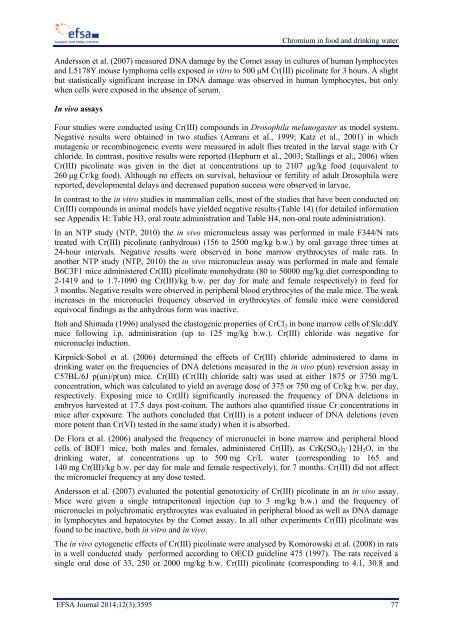efsa-opinion-chromium-food-drinking-water
efsa-opinion-chromium-food-drinking-water
efsa-opinion-chromium-food-drinking-water
You also want an ePaper? Increase the reach of your titles
YUMPU automatically turns print PDFs into web optimized ePapers that Google loves.
Chromium in <strong>food</strong> and <strong>drinking</strong> <strong>water</strong><br />
Andersson et al. (2007) measured DNA damage by the Comet assay in cultures of human lymphocytes<br />
and L5178Y mouse lymphoma cells exposed in vitro to 500 μM Cr(III) picolinate for 3 hours. A slight<br />
but statistically significant increase in DNA damage was observed in human lymphocytes, but only<br />
when cells were exposed in the absence of serum.<br />
In vivo assays<br />
Four studies were conducted using Cr(III) compounds in Drosophila melanogaster as model system.<br />
Negative results were obtained in two studies (Amrani et al., 1999; Katz et al., 2001) in which<br />
mutagenic or recombinogeneic events were measured in adult flies treated in the larval stage with Cr<br />
chloride. In contrast, positive results were reported (Hepburn et al., 2003; Stallings et al., 2006) when<br />
Cr(III) picolinate was given in the diet at concentrations up to 2107 μg/kg <strong>food</strong> (equivalent to<br />
260 μg Cr/kg <strong>food</strong>). Although no effects on survival, behaviour or fertility of adult Drosophila were<br />
reported, developmental delays and decreased pupation success were observed in larvae.<br />
In contrast to the in vitro studies in mammalian cells, most of the studies that have been conducted on<br />
Cr(III) compounds in animal models have yielded negative results (Table 14) (for detailed information<br />
see Appendix H: Table H3, oral route administration and Table H4, non-oral route administration).<br />
In an NTP study (NTP, 2010) the in vivo micronucleus assay was performed in male F344/N rats<br />
treated with Cr(III) picolinate (anhydrous) (156 to 2500 mg/kg b.w.) by oral gavage three times at<br />
24-hour intervals. Negative results were observed in bone marrow erythrocytes of male rats. In<br />
another NTP study (NTP, 2010) the in vivo micronucleus assay was performed in male and female<br />
B6C3F1 mice administered Cr(III) picolinate monohydrate (80 to 50000 mg/kg diet corresponding to<br />
2-1419 and to 1.7-1090 mg Cr(III)/kg b.w. per day for male and female respectively) in feed for<br />
3 months. Negative results were observed in peripheral blood erythrocytes of the male mice. The weak<br />
increases in the micronuclei frequency observed in erythrocytes of female mice were considered<br />
equivocal findings as the anhydrous form was inactive.<br />
Itoh and Shimada (1996) analysed the clastogenic properties of CrCl 3 in bone marrow cells of Slc:ddY<br />
mice following i.p. administration (up to 125 mg/kg b.w.). Cr(III) chloride was negative for<br />
micronuclei induction.<br />
Kirpnick-Sobol et al. (2006) determined the effects of Cr(III) chloride administered to dams in<br />
<strong>drinking</strong> <strong>water</strong> on the frequencies of DNA deletions measured in the in vivo p(un) reversion assay in<br />
C57BL/6J p(un)/p(un) mice. Cr(III) (Cr(III) chloride salt) was used at either 1875 or 3750 mg/L<br />
concentration, which was calculated to yield an average dose of 375 or 750 mg of Cr/kg b.w. per day,<br />
respectively. Exposing mice to Cr(III) significantly increased the frequency of DNA deletions in<br />
embryos harvested at 17.5 days post-coitum. The authors also quantified tissue Cr concentrations in<br />
mice after exposure. The authors concluded that Cr(III) is a potent inducer of DNA deletions (even<br />
more potent than Cr(VI) tested in the same study) when it is absorbed.<br />
De Flora et al. (2006) analysed the frequency of micronuclei in bone marrow and peripheral blood<br />
cells of BDF1 mice, both males and females, administered Cr(III), as CrK(SO 4 ) 2·12H 2 O, in the<br />
<strong>drinking</strong> <strong>water</strong>, at concentrations up to 500 mg Cr/L <strong>water</strong> (corresponding to 165 and<br />
140 mg Cr(III)/kg b.w. per day for male and female respectively), for 7 months. Cr(III) did not affect<br />
the micronuclei frequency at any dose tested.<br />
Andersson et al. (2007) evaluated the potential genotoxicity of Cr(III) picolinate in an in vivo assay.<br />
Mice were given a single intraperitoneal injection (up to 3 mg/kg b.w.) and the frequency of<br />
micronuclei in polychromatic erythrocytes was evaluated in peripheral blood as well as DNA damage<br />
in lymphocytes and hepatocytes by the Comet assay. In all other experiments Cr(III) picolinate was<br />
found to be inactive, both in vitro and in vivo.<br />
The in vivo cytogenetic effects of Cr(III) picolinate were analysed by Komorowski et al. (2008) in rats<br />
in a well conducted study performed according to OECD guideline 475 (1997). The rats received a<br />
single oral dose of 33, 250 or 2000 mg/kg b.w. Cr(III) picolinate (corresponding to 4.1, 30.8 and<br />
EFSA Journal 2014;12(3):3595 77



